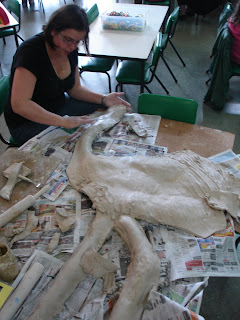Everybody's asking "What happens now?'
The pieces that we have made out of clay for our mosaic ( at least 108 leaves, 60 hands, two trees, letters that spell Bellevue Hill preschool and at least 25 creatures) have to dry out for about one or two weeks before they can be put into the kiln. Then they can be fired to 100 degrees centrigrade. This is called the bisque firing.
After this Debbie will need to glaze all of the pottery and put it into the kiln again. This firing it called the glaze firing and it is the part where the clayworks are made shiny. This time the firing goes higher to 1070 degrees. It's the same process used to make the crockery that you use at home - your cups and plates etc.
Hopefully at around Melbourne cup week, there will be enough clay works fired and ready to put onto the wall and Debbie will be able to start the mosaic. The first works to be put up will be the bigger animals like the emu and kangaroo, the swan, platypus, koalas, possum and snake. Then the rest of the mosaic will be built around these pieces.
It is envisaged that the mosaic will take about fifteen days to make. As Debbie also has a couple of other jobs, she won't be working on it every day. But she will be there at least once or twice a week and the mosaic should be completed before the end of the school year. If you want to learn how to mosaic, there is an opportunity to work with Debbie. Let Irena know, if you want to be part of this.

Here is the pottery room at the Boilerhouse in Sunbury, where the works will be fired. Some of the clay works are here on the shelves drying out. The rest are at Debbie's house E V E R Y W H E R E !!!

Here is the kiln that the clay pieces will be fired in. It is a lot bigger than an oven and can be heated to four times the temperature of your oven at home. A powerful oven.
On the bottom shelf are the grasses that the children made in the first thursday workshop.



























